Light day for tomato seedlings
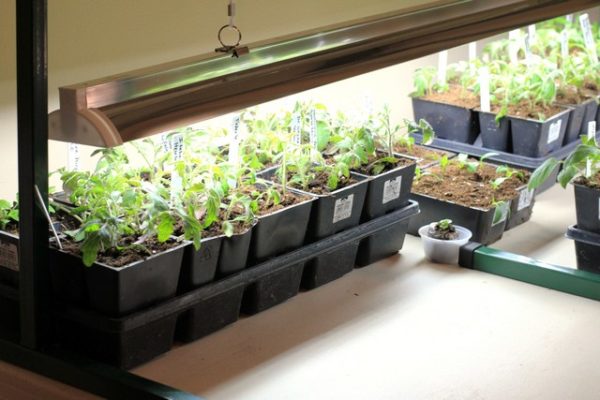
Light day for tomato seedlings should be observed in accordance with its vegetative age and highlighting can help. To understand the issues of illumination is not difficult. Knowing the parameters and what exactly the tomatoes need in the seedling period can easily achieve excellent results.
Target illumination
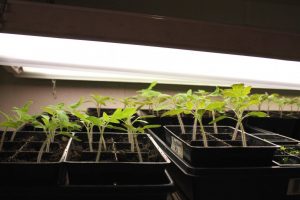 Is the backlight important? If an adult plant has already passed the stage of rapid division and reacts little to the amount of luminous flux, then for a growing tomato regularity and quality of illumination is of great importance.
Is the backlight important? If an adult plant has already passed the stage of rapid division and reacts little to the amount of luminous flux, then for a growing tomato regularity and quality of illumination is of great importance.
It matters not only the spectral composition, but also the distance from the source. For example, to stimulate germination, a red light is needed, but a distant source will suppress this process. At a closer distance, this spectrum has a positive effect on growth processes.
To keep the growth of the stem, and not to allow the internodes to increase greatly, and the tomato seedlings to stretch, gentle blue spectrum. Tomato cells react to it by dividing, and the stem becomes thicker.
If we estimate the overall illumination, then its increase helps to accelerate flowering, the timing of the laying of the first brush is reduced, the number of leaves decreases, to flower first acid.
To determine how much to highlight the seedlings of tomatoes and what kind of lamps to do it most optimally, you should consider some of the nuances.
See also: Chinese way of growing tomato seedlings
Key recommendations
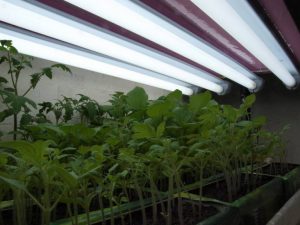 To understand how to properly highlight tomato seedlings you need to remember that:
To understand how to properly highlight tomato seedlings you need to remember that:
- Light power is measured in lumens, with their larger value, more and light;
- Illumination is prescribed in the suites.
It looks like this: If a stream of light of 1 Lm illuminates 1 square meter, then the illumination is 1 Lx
From the physics course it is also necessary to recall that the illumination is inversely proportional to the square of the distance from the radiator to the plant. This means that if the source of oars is 0.5 m, and you raised it by 1 m (doubled the distance), the illumination will be 4 times less. When planning a system, you can use this form:
- If from the point of illumination to the plant 1 m, then the illumination is 1000 Lx;
- 2 m, respectively, 250 Lx;
- 3 m - 111 Lk.
The dependence on the degree of the angle under which the luminous flux is directed is also great. When mounting the system, it is better that the light falls perpendicular to the seedlings.
If the sides of the area with seedlings equip reflectors, the efficiency of illumination will improve significantly.
When and how much to highlight?
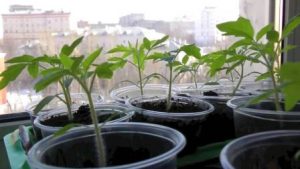 Even having mounted the illumination system observing all the laws of physics, it is necessary to clearly know what period and how much to illuminate the seedlings. In order not to be mistaken in the calculations and to understand how much to illuminate the seedlings of tomatoes, it is necessary to take into account that the process of photosynthesis takes place only in the light.
Even having mounted the illumination system observing all the laws of physics, it is necessary to clearly know what period and how much to illuminate the seedlings. In order not to be mistaken in the calculations and to understand how much to illuminate the seedlings of tomatoes, it is necessary to take into account that the process of photosynthesis takes place only in the light.
In order to carry out the process correctly, you should use the following recommendations:
- As soon as shoots appeared: the length of daylight is 24 hours, and so on for 2-3 days;
- The phase of the seedling plant (before picking) must be provided for 16 hours over 10-12 hours;
- After diving, up to 30 days of age, you need 16 hours of daylight hours;
- From 30 days old to 60 days old not less than 14 hours.
When figuring out when to highlight tomato seedlings, it should be noted that daylight should not be interrupted, it should be continuous. But you can increase it as in the morning hours, evenly distributing between morning and evening.
Which illuminator to choose?
To make the right choice, you need to choose:
- Power;
- Color spectrum;
- Efficiency;
See also: Ways to grow tomato seedlings
To make the information intelligible, we consider only those illuminators that are suitable for highlighting, but in terms of efficiency.
Fluorescent lamps
If, for example, we choose a lamp with a power of 36 W, a lifetime of 20,000, with cold white light, a luminous flux of 3350 Lm and a long lamp of 1200 mm, and we will hang it above the worktop at 35 cm, then for an area of 1.5x2 such lamps will need 6 pieces.
High Pressure Mirror Lamp
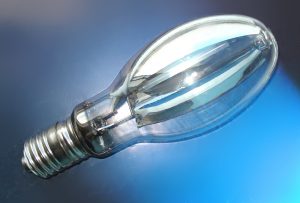 If we take the modification DNAZ / Reflux 250, then choosing such a lamp with the characteristics of a power of 250 W and a luminous flux of 26000, it will be enough for one to illuminate the entire seating area for our calculations.
If we take the modification DNAZ / Reflux 250, then choosing such a lamp with the characteristics of a power of 250 W and a luminous flux of 26000, it will be enough for one to illuminate the entire seating area for our calculations.
Modification of the Bottom3 / Reflux 70 Will have a power of 70 W and a luminous flux of 5600, then there are three such illuminators.
As a rule, it is such illuminators that are mounted in the lamps for plants.
Let's compare the light output, advantages and disadvantages
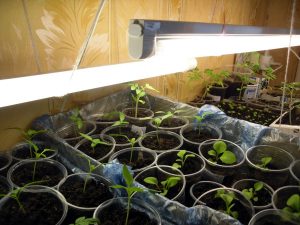
- Incandescent - low light, about 17 lm / watt;
- Halogen - the life of this lamp is several times higher, the light output is about 25 lm / watt, the color temperature as a brightness unit is also 2800 28K., The light of such a lamp is yellow;
- Xenon discharge lamp - color temperature 4300 and the lighting of seedlings of tomatoes will be more effective. Such a lamp gives blue light and its light output is about 70 lm / watt;
- The fluorescent lamp will show a light output of 70-100 lm / watt;
- Linear lamps - their diameter can be 16 mm or 26 mm, very often such lamps are used if there is no natural light at all. A high level of blue and red emission spectrum contributes to the optimal course of photosynthesis, while accelerating the growth and development of seedlings. Light output at 47-100 lm / watt;
- High-pressure sodium vapor lamps DNaT - the main spectrum of light emitted by these lamps is red. It helps to strengthen the roots and budding, as well as flowering. Experienced vegetable growers, knowing what kind of light is needed for tomato seedlings, in a certain period, this type of lamp is used for seedlings aged 30-60 days. Light output of a sodium radiator is up to 200 lm / watt. The same type, but with a modification of the DNaZ lamp, has a mirror coating, a reflective layer. Such an illuminator lasts longer, its efficiency is greater and reaches 95%;
- Metal halide (DID) lamps. Today it is the most efficient lamps with a high light transmission coefficient. 100 lm / watt is their light output;
- LED lamps - the ratio of power consumption and efficiency is very high, this is what puts this type of lamp in the first place, so that there is a backlight for tomatoes on the windowsill.
What kind of highlight you would choose the best seedlings placed on the window sills windows with a southern orientation.
Each vegetable grower chooses the schedule of such which best would satisfy him. However, when choosing, one should take into account that both the interruption of the luminous flux and its change in one or the other direction negatively affects the plant organism.
Backlight quality control
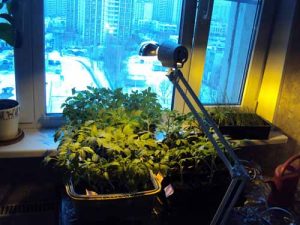 No matter how highlight, industrial lighting, or an LED lamp for tomato seedlings made with your own hands, and at their discretion, in any case, the light should be distributed evenly throughout the plant cells.
No matter how highlight, industrial lighting, or an LED lamp for tomato seedlings made with your own hands, and at their discretion, in any case, the light should be distributed evenly throughout the plant cells.
If any area is not sufficiently illuminated, after a while it will be noticeable, since the seedlings will be drawn out or have a pale green color. In this case, you need to adjust both the angle of illumination and the distance.
An indicator of insufficient illumination is also the “stretching” of sprouts in the direction of the window; normally, seedlings should grow strictly vertically.
See also: We grow tomato seedlings for the greenhouse
Taking the highlight, do not try to immediately cover a large area. Try one area, making sure the correct choice of the light power of the lamp and the level of highlighting, you can expand the area.
Growing tomato seedlings, it should be remembered that its quality is influenced, besides the light, also by a temperature indicator, as well as the nutritional value of the soil.
Video: All about highlighting tomato seedlings


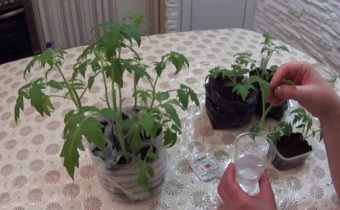
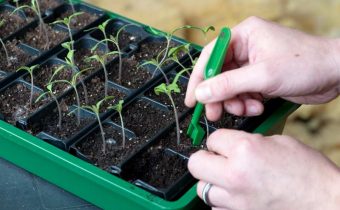
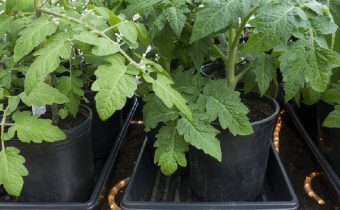
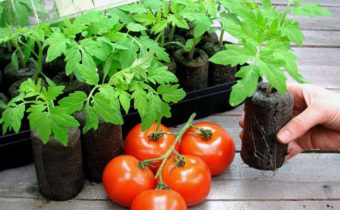
Daria
In our region in the summer, and in other as well as in the spring, usually light laziness is very long. In the summer, it can last up to 9 pm. However, due to the fact that it often rains, there is simply not enough light for seedlings. Therefore, I always light up. The main thing is to choose the right lamp for these purposes and observe the temperature regime. Excess is also not good.
Alex
I illuminated my seedlings (flowers) at the dacha for 12 days continuously with fluorescent lamps with a reflector from a distance of 15 cm (illumination on the ground is about 10,000 LL). She looks just great. Now I put the socket-timer (18 hours). Let's see what grow out of it